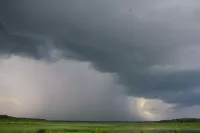The Missouri River, the longest in the U.S. at 2,341 miles, originates in the Rocky Mountains of Montana and flows east and south to join the Mississippi River near St. Louis. Its vast watershed drains over 500,000 square miles across ten U.S. states and two Canadian provinces. Despite being a Mississippi tributary, the Missouri is slightly longer with a similar water volume. Together with the lower Mississippi, it forms the fourth-longest river system globally.
1907: Hauser Dam Completion
In 1907, the steel Hauser Dam was completed, but failed in 1908 due to structural deficiencies.
1908: Hauser Dam Failure
In 1908, the Hauser Dam failed due to structural deficiencies, causing catastrophic flooding downstream, prompting the dynamiting of a section of the Black Eagle Dam.
1910: Hauser Dam Rebuilt
In 1910, the Hauser Dam was rebuilt as a concrete gravity structure, and it stands to this day.
1912: USACE Authorized to Maintain Missouri River Depth
In 1912, the USACE was authorized to maintain the Missouri River to a depth of six feet from the Port of Kansas City to the mouth.
1913: Ryan Dam Construction
In 1913, Ryan Dam, the largest of the five dams near Great Falls, was built directly above the 87-foot Big Falls, the largest waterfall of the Missouri.
1918: Holter Dam Completion
In 1918, Holter Dam was completed by the Montana Power Company and the United Missouri River Power Company, flooding the Gates of the Mountains canyon.
1925: USACE Begins Widening Navigation Channel
In 1925, the USACE began a project to widen the Missouri River's navigation channel to 200 feet.
1926: Catastrophic Floods
From 1926 to 1927, the Missouri basin suffered a series of catastrophic floods.
1926: Black Eagle Dam Replacement
In 1926, the original Black Eagle Dam, built in 1891, was replaced with a more modern structure, diverting part of the Missouri's flow into the Black Eagle power plant.
1927: Catastrophic Floods
From 1926 to 1927, the Missouri basin suffered a series of catastrophic floods.
1929: Estimated Annual Goods Shipped
In 1929, the Missouri River Navigation Commission estimated the amount of goods shipped on the river annually at 15 million tons.
1940: End of dam construction near Great Falls
By 1940, five dams had been constructed in the vicinity of Great Falls to generate power from the Great Falls of the Missouri.
1940: Fort Peck Dam Completion
In 1940, as part of the Great Depression-era New Deal, the U.S. Army Corps of Engineers completed Fort Peck Dam in Montana, providing flood control.
1944: Flood Control Act of 1944
In 1944, Congress passed the Flood Control Act of 1944, authorizing the Pick–Sloan Missouri Basin Program for large-scale development of the Missouri River.
1945: Missouri River Bank Stabilization and Navigation Project
In 1945, the USACE began the Missouri River Bank Stabilization and Navigation Project, increasing the river's navigation channel.
1947: Settlement Coercion for Fort Berthold Land
In 1947, the Mandan, Hidatsa and Arikara tribes were coerced into accepting a $5.1 million settlement for land taken by the construction of Garrison Dam, just $33 per acre.
1949: Canyon Ferry Dam Construction Begins
In 1949, the U.S. Bureau of Reclamation began construction on the modern Canyon Ferry Dam to provide flood control to the Great Falls area.
1949: Increased Settlement for Fort Berthold Land
In 1949, the settlement for land taken from the Mandan, Hidatsa and Arikara tribes for the construction of Garrison Dam was increased to $12.6 million.
1954: Canyon Ferry Lake Submerges Old Dam
By 1954, the rising waters of Canyon Ferry Lake submerged the old 1898 dam, whose powerhouse still stands underwater.
1960: Extreme Maxima Temperatures
Prior to 1960, extreme maximum temperatures exceeded 115 °F in all U.S. states within the Missouri River basin.
December 23, 1963: Lowest Discharge Due to Ice Dam
On December 23, 1963, the lowest discharge ever recorded on the Missouri River occurred due to the formation of an ice dam, measuring a mere 602 cu ft/s.
1965: Federal Water Project Recreation Act spurs facility development
In 1965, the Federal Water Project Recreation Act mandated the USACE to construct and maintain public facilities such as boat ramps and campgrounds along major reservoirs, boosting recreational opportunities.
1972: Black Hills Flood
In 1972, Rapid City, South Dakota, experienced the Black Hills flood, triggered by an intense summer thunderstorm in the upper Missouri River basin.
1976: Missouri Breaks designated as U.S. National Wild and Scenic River
In 1976, a 149-mile (240 km) stretch of the Missouri River through the Missouri Breaks was designated a U.S. National Wild and Scenic River. This area, part of the Upper Missouri Breaks National Monument, features diverse landscapes and recreational opportunities.
1977: Goods Shipped
In 1977, 3.3 million short tons of goods were shipped on the Missouri River.
1990: Missouri River Watershed Population
In 1990, the Missouri River watershed was home to approximately 12 million people, including the entire state of Nebraska and portions of several other U.S. states and Canadian provinces.
1990: Missouri River reservoir visitation increases
In 1990, visitor-hours to the six reservoirs of the Missouri River Mainstem System increased to over 60 million, up from 10 million in the mid-1960s. The recreational use of these reservoirs is estimated to contribute $85–100 million to the regional economy each year.
July 31, 1993: Historic Flood Discharge
On July 31, 1993, the largest discharge ever recorded on the Missouri River occurred during a historic flood, measuring over 750,000 cu ft/s.
1993: Historic Floods
Historic floods occurred on the Missouri River in 1993.
1994: Average Annual Shipment Tonnage
From 1994 to 2006, shipments of commodities on the Missouri River averaged only 683,000 tons per year.
2000: Goods Plunged to 1.3 Million Short Tons
In 2000, the amount of goods shipped on the Missouri River plunged from 3.3 million short tons in 1977 to just 1.3 million short tons.
2000: Increase in Shipments
In 2010, about 334,000 short tons were barged on the Missouri River, representing the first significant increase in shipments since 2000.
2001: Floodplain Restoration
By 2001, there were 87,000 acres of riverside floodplain undergoing active restoration along the lower Missouri River.
2005: Front Range Urban Corridor Population
In 2005, the Front Range Urban Corridor, with Denver as its main city, had a combined population of over four million, making it the largest metropolitan area in the Missouri River basin.
2006: Average Annual Shipment Tonnage
From 1994 to 2006, shipments of commodities on the Missouri River averaged only 683,000 tons per year.
2006: Barges Hauled
In 2006, barges on the Missouri River hauled only 200,000 short tons of products, which is equal to the daily freight traffic on the Mississippi.
2006: Commercial Barges Run Aground
In 2006, the U.S. Coast Guard stated that commercial barge tows ran aground in the Missouri River due to severe silting of the navigation channel.
2006: Lowest Annual Mean Flow
In 2006, the lowest annual mean flow of the Missouri River at Hermann, Missouri, was recorded at 41,690 cu ft/s.
2008: Cargo Average on Upper Mississippi
From 2008 to 2011, the upper Mississippi averaged 61.3 million tons of cargo annually.
2010: Average Annual Flow Measurement
From 1897 to 2010, the average annual flow of the Missouri River at Hermann, Missouri, was 87,520 cu ft/s.
2010: Increase in Shipments
In 2010, about 334,000 short tons were barged on the Missouri River, representing the first significant increase in shipments since 2000.
2010: National Research Council report on Missouri River sediment
In 2010, the National Research Council issued a report assessing the role of sediment in the Missouri River. The report evaluated habitat restoration strategies and suggested the creation of a "sediment budget" to improve water quality and protect endangered species.
2011: Cargo Average on Upper Mississippi
From 2008 to 2011, the upper Mississippi averaged 61.3 million tons of cargo annually.
2011: Historic Floods
Historic floods occurred on the Missouri River in 2011.
2011: Flooding Closes River to Boat Traffic
In 2011, flooding closed record stretches of the Missouri River to boat traffic, hindering hopes for a bounce-back year in shipping.
Mentioned in this timeline

Thunderstorms also known as electrical or lightning storms are characterized...
Montana a landlocked state in the Mountain West is bordered...
Denver is the capital and most populous city of Colorado...
Mississippi is a state in the Southeastern and Deep South...
Kansas is a Midwestern U S state bordered by Nebraska...

A bank is a financial institution that plays a crucial...
Trending
7 months ago Air India Dreamliner Forced to Return to Hong Kong Due to Technical Problems

5 months ago Travis Scott Surpasses Eminem as Second Most Streamed Rapper on Spotify

Michael Lee McDaniel is the head coach of the Miami Dolphins He started his NFL career as an intern for...

7 months ago Jenna Bush Hager Debuts Bob Cut and Shares Tasty Queso Dip Recipe.

Samsung Group is a South Korean multinational manufacturing conglomerate and the largest chaebol in South Korea Headquartered in Seoul the...

6 months ago Morgan Wallen Headlines Camp Randall Concert After 28-Year Hiatus, Benefiting Madison Residents.
Popular

Stranger Things created by the Duffer Brothers is a popular...

XXXTentacion born Jahseh Dwayne Ricardo Onfroy was a controversial yet...
Turning Point USA TPUSA is an American nonprofit organization founded...

Bernie Sanders is a prominent American politician currently serving as...

Jupiter is the fifth and largest planet from the Sun...

Candace Owens is an American conservative political commentator and author...